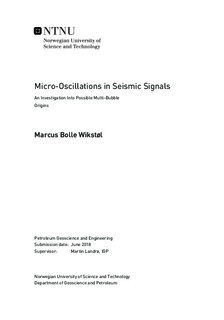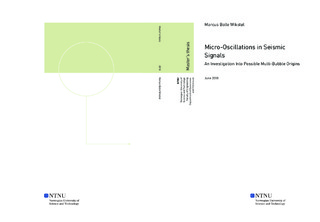| dc.description.abstract | Since its first use in the early 20th century, seismic acquisition has become the most utilised method of marine hydrocarbon exploration. At its core, the method relies upon pressure imbalances between a bubble of pressurised air and the water it was released into to create an image of the subsurface: In an idealised world, the interplay between the two would only cause periodic pressure wave emissions of decreasing magnitudes. These are indeed seen in the real world, but they are often superpositioned by a number of weaker oscillations with a higher frequency. Traditionally these have been considered as noise, but a recent survey experiment performed in the Trondheim Fjord indicates that they are highly repeatable. If a theory could predict their behaviour, they could be used to increase the signal-to-noise record in seismic datasets - which in essence is the goal of seismic processing. However, to predict them it is first necessary to ascertain their origin. This thesis is hence an investigation into the possible phenomena and mechanisms that might generate such ``micro-oscillations'', and deals primarily with two hypotheses:
- The oscillations are created by the precursor ``bubble'', which forms before the dominant bubble in the system (henceforth referred to as the ``main bubble''), and oscillates with its own period. Through its proximity to the main bubble it is subject to large amounts of incident acoustic radiation, which might at every major pressure pulse ``charge'' it and extend its lifetime.
- The oscillations owe their existence to smaller bubbles which by some process split from the main bubble. Evidence is presented here that the partition might be due to the bubble interacting with the surface.
In order to investigate these hypotheses, bubble oscillation needed to be modelled under a wide range of conditions. With this in mind, a composite bubble dynamics equation was put together by including elements from a number of authors. The main bubble's behaviour was modelled by iteratively solving said equation under the guidance of a genetic algorithm developed for the occasion. Having isolated the main bubble's behaviour, it was subtracted from the dataset to yield the micro-oscillations. The same inversion-scheme was used to inverse-model these smaller oscillations.
Succinctly, the results of said inverse-modelling provide a strong argument for discarding the precursor hypothesis. The precursor, forming before the main bubble, will not retain the high-frequency oscillations otherwise expected from its initial pressure-volume imbalance for long. Rather, it will oscillate at near the same period as the larger bubble whose pressure emissions it is subject to.
If a bubble instead is allowed to form in the interlude between the main bubble's pressure pulses (hypothesis II), inverse-modelling proves it capable of generating some of the micro-oscillations observed. This does not necessarily prove the validity of the bubble spawn hypothesis, but it is a strong point in its favour until a dedicated experiment is performed to investigate it. The most convincing results were produced in the time between the first main bubble expansion and collapse. Worse results were achieved for the post-collapse micro-oscillations: Only the modelling of the deeper dataset treated managed to reproduce the measured signature to an acceptable degree. This drop in correlation might be due to the collapse causing an intensification of bubble spawning through the ensuing turbulence: The increased number of spawned bubbles (potentially of varying sizes) is likely to interact to a higher degree, and their combined signature could not be reproduced by modelling just one of them.
When determining the optimal frequency range for inverse-modelling the micro-oscillations, it was for thoroughness deemed necessary to compare their power spectra to that of an equally long noise record. The datasets available for analysis had, however, had their pre-shot record muted. A process was thus developed to find the time at which the main bubble no longer influenced measurements, and a noise record unbiased by bubble oscillation could be extracted. | |

